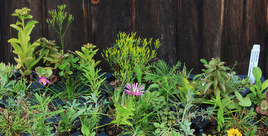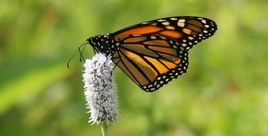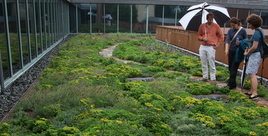Green Roof FAQs
What’s the difference between an Extensive green roof and an Intensive green roof?
An extensive green roof has low lying plants designed to provide maximum groundcover, water retention, erosion resistance, and respirative transpiration of moisture. Extensive green roofs usually use plants with foliage from 2 to 6 inches and from 2 to 4 inches of soil.
An intensive green roof is intended to be more of a natural landscape, installed on a rooftop. Intensive green roofs may use plants with foliage from 1 to 15 feet and may require several feet of soil depth.
At Emory Knoll Farms, we specialize in providing plants for extensive green roofs and the remaining questions here in the FAQ section are focused on the issues of extensive green roofs.
What are the qualities of a good extensive green roof plant?
Ideally, green roof plants should incorporate most of these characteristics:
- Low growth height
- Rapid growth / spreading
- High drought tolerance
- Fibrous root as opposed to tap roots to protect roofing membranes
- No special irrigation or nutritional requirements
- Low maintenance – trimming, weeding, feeding
- Plants shouldn’t generate airborne seeds in order to prevent the green roof plants invading other landscaping.
What plants should I put on an extensive green roof?
There are several design considerations for selecting plants for a green roof project. These might include:
- Climate
- Initial cost and maintenance costs
- What’s the objective of the roof?
- Stormwater management
- Energy conservation
- Heat Island Mitigation
- Aesthetics
- Soil Depth
- Irrigated or non-irrigated
- What are the aesthetic considerations:
- Evergreen or deciduous?
- Public use?
- Depth of foliage
All of these factors and many more will guide the plant selection. We are available to discuss options with architects, builders, and planners. Contact us to learn what choices might fulfill your specific needs.
Can people walk on the green roof?
Generally, extensive green roofs are not designed for pedestrian traffic. But the occasional incursion by an inspector or maintenance worker would not be a problem for most commonly used plants.
What will my green roof look like in the winter time? Will the foliage disappear?
A green roof can be designed to be evergreen or deciduous in accordance with the preferences of the client. There are always tradeoffs between summertime beauty and winter foliage. Many deciduous plants will offer bright and extensive summertime blossoms, while evergreen plants might be more subdued.
What about allergens added to the air by the plants on the roof?
This is a potentially important consideration in developing a plant list. Green roof plants don’t necessarily generate more pollen or more aggravating forms of pollen than other landscape plants. The designer should consider plant selection as well as technological solutions such as HEPA filter on the HVAC system. We recommend that an air quality specialist should guide any final actions.
I would like to use native plants for my green roof project. Which varieties are appropriate?
Some native North American plants are appropriate for use on green roofs, but they often bring extra costs. For example, in the eastern US, there are not many choices of native plants which would be expected to thrive on a green roof without additional requirements such as irrigation. Intensive green roofs might allow for more use of natives; if extra soil, shade, and irrigation are allowed for. But for extensive green roofs there are few choices of native plants which could reasonably be expected to thrive.
Relative to a green roof, what are the differences between using hearty succulents and grasses or perennials?
Many succulents operate with Crassulacean Acid Metabolism or CAM. In plants which use CAM, carbon dioxide is taken in through stomata with the simultaneous loss of water vapor. By only requiring the stomata to be open during the (cooler) night for carbon dioxide uptake and keeping them closed during the (hotter) day, the plants lose much less water. In extremely arid conditions, some CAM plants can permanently close their stomata so preventing any water loss. During these times, the plant growth might be inhibited, but the plants can maintain the healthy state of the cells.
What this means is that for a non-irrigated roof, non CAM plants such as perennials and grasses will be much more susceptible to heat and drought.
Grasses & perennials generally have more mass and generally require more soil depth than succulents. These plants are designed by nature to build biomass and this additional mass creates additional requirements for the roof as compared to succulents. Such requirements include a potential increase in the load-bearing requirement of the roof or additional watering and maintenance for trimming.
What about sloped roofs?
In Germany, there is experience with green roofs of up to a 45-degree pitch. But the complexity increases with pitch; as soil baffles, drainage, and other considerations may come into play. Consult your architect or builder to assess your particular situation.
Can I put a green roof on my existing residence?
Many people have realized the benefits of a green roof on their own home. For either existing dwellings or new construction, one should always consult a structural engineer to determine the structural requirements of a green roof.
If you have a question about green roofs, please call us at 410-452-5880.


